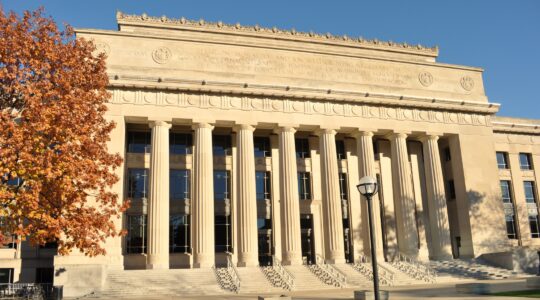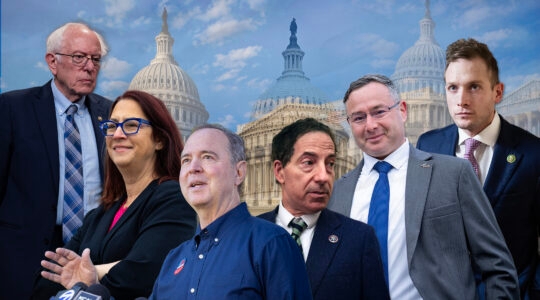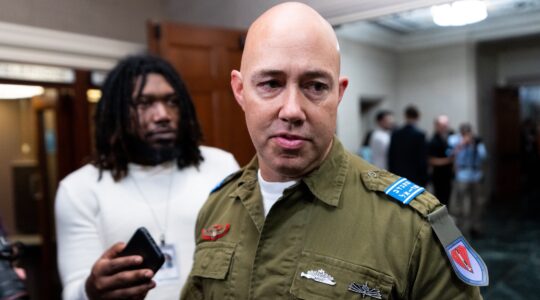BOSTON (JTA) – Any student of American labor history knows the name Samuel Gompers, founder of the American Federation of Labor in 1886. He was hugely influential in U.S. politics and left an indelible mark on the lives of millions of working Americans.
Not so familiar is the name Edward Cohen, a fellow Jewish immigrant cigar maker from London and Gompers’ friend and protégé.
Cohen served as president of the Massachusetts branch of the American Federation of Labor during its formative years in the early 1900s, gaining the admiration of his fellow workers and a host of prominent figures, including Louis Brandeis, who later went on to become the first Jewish Supreme Court justice.
Now, a century after his death, Cohen’s place in American labor history is being recognized.
A large, intricately carved bronze plaque commemorating Cohen and acknowledging his contributions as an influential labor leader soon will be permanently installed at the historic Massachusetts State House. The president of the Massachusetts AFL-CIO, Robert Haynes, who rediscovered Cohen’s story about a decade ago while looking through old union records, called the installation of the plaque one of the greatest moments in the history of the Massachusetts AFL-CIO.
Through extensive research and exclusive interviews with several descendants of the family, JTA has discovered documents not previously associated with Cohen that shed new light on his significance in the cannon of American labor history.
Cohen fought for a wide variety of causes, including worker safety and child labor restrictions. He also supported the cause of women’s suffrage and, according to Brandeis, was instrumental in the adoption of the nation’s first savings bank life insurance program.
Cohen’s steady rise was tragically cut short when he was killed in a bizarre shooting accident at the Beacon Hill office of the Massachusetts governor at the time, Curtis Guild. On Dec. 5, 1907, Cohen, then 47, was sitting with two of his union allies in the anteroom of the governor’s office at the state house when James Steele, a man who recently had been released from a mental institution, began shooting at random. Cohen was killed and one of his union allies was seriously injured.
Cohen’s murder dominated Boston news headlines for days. Some 12,000 people turned out to mourn his death, with a dignitary-led funeral procession through the streets of Boston.
Over the ensuing decades, however, Cohen largely was forgotten – no more so than in the Jewish community, even in sectors active in the labor movement.
Then, last December, 100 years after Cohen’s murder, a ceremony was held at the Massachusetts State House unveiling a portrait of the plaque soon to be installed. The plaque was designed by Meredith Bergmann, an award-winning sculptor from New York.
The ceremony served as a kind of mini-family reunion among long-lost relatives, said Harry Greenberger, one of Cohen’s grandchildren, who was among six Cohen descendants who attended the ceremony at the state house.
On a Sunday morning last spring, Phyllis Cohen Feltzer, one of Cohen’s granddaughters, sat with JTA in New York and shared one of two old family scrapbooks containing unpublished letters and telegrams relating to Cohen.
Among the dozens of letters and telegrams sent to Cohen’s widow, who moved to New York with their eight children, are notes from Gompers, the governor and Boston Mayor John “Honey” Fitzgerald, grandfather of John F. Kennedy.
“It is quite a significant accomplishment that a Jewish person would become the head of a major organization in Massachusetts” in the early 1900s, said James Green, professor of history and labor studies at the University of Massachusetts-Boston.
Little is known about Cohen’s religious beliefs or practice. He was buried by the Sons of Benjamin in a Jewish cemetery in Brooklyn, and some of his few known relatives identify themselves as Jewish. A search of Jewish newspapers from the time turned up only one article about Cohen’s death, in Der Tog Morgn Zjournal, a prominent Yiddish paper in New York, according to a librarian at the YIVO Institute for Jewish Research.
After immigrating to New York from London in 1880 at age of 22, Cohen and his wife, Rebecca Williams, eventually settled in Lynn, Mass., where he quickly rose through Boston-area union ranks. In 1906, he was elected president of the Massachusetts branch of the American Federation of Labor.
In that post, Cohen served on the state’s Commission on Commerce and Industry alongside Brandeis, who, before his appointment to the U.S. Supreme Court in 1916, was gaining prominence as a lawyer and social reformer.
In letters from Brandeis to Gompers, and others written in the spring of 1907, Brandeis indicated that Cohen was an instrumental labor figure with close personal ties to the governor, who pushed for the adoption of the first law establishing a savings bank life insurance program, one of Brandeis’ initiatives.
These letters are cited in a collection of Brandeis’ correspondence edited by historians Melvin Urofsky and David Levy.
Gompers and Cohen exchanged at least seven letters in the decade before Cohen’s death, according to Grace Palladino, co-director of the Samuel Gompers Papers at the University of Maryland College Park.
In one, dated Nov. 24, 1897, Gompers wrote to Cohen: “It was a pleasure to hear from you, for I remember well the time when working together as shop mates we had many pleasant and interesting discussions on the very principles for which I have the larger opportunity now of contending.”
A Boston Globe newspaper account from the time reported that Cohen was to have dined at Brandeis’ home the night Cohen was killed. While he cannot confirm that detail, Urofsky, now a professor of law and public policy at Virginia Commonwealth University, says it’s his educated guess that they probably were invited.
Brandeis was one of the dozens of ushers for Cohen’s public funeral procession. In a letter the next day, he described Cohen’s death a severe loss to organized labor.
“He was among its best and ablest representatives and has deserved and secured the confidence of a large part of the community,” Brandeis wrote in a letter to the secretary of the Boston central labor council, Henry Abrahams.
When she met with JTA recently near her home in Queens, Feltzer read aloud from a handwritten letter to Cohen’s widow from Mrs. James Steele, the mother of Cohen’s assassin. The letter, dated Dec. 18, 1907, expressed Steele’s sorrow and sympathy for the loss of a loving husband and father.
“I must express my sorrow and sympathy in the irreparable [loss] of a loving husband and father,” Steele wrote. “Believe me there could not have been at the bedside of your dying husband a more heartfelt sincere mourner.”
“I’m crying every time I read it,” Feltzer told JTA. “It’s phenomenal.”
Feltzer, who grew up in the Bronx, recalls childhood visits to her grandmother, Rebecca Cohen, who lived in the Endicott Hotel near the American Museum of Natural History in Manhattan.
Echoing other descendants of Cohen interviewed by JTA, Feltzer said there was little discussion in her family of the details of her grandfather’s life or death.
JTA has documented Jewish history in real-time for over a century. Keep our journalism strong by joining us in supporting independent, award-winning reporting.





